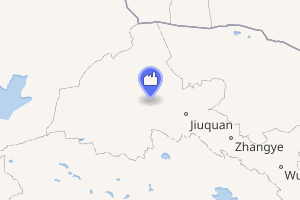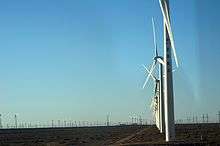Gansu Wind Farm
The Gansu Wind Farm Project or Jiuquan Wind Power Base is a group of large wind farms under construction in western Gansu province in China. The Gansu Wind Farm Project is located in desert areas near the city of Jiuquan in two localities of Guazhou County and also near Yumen City, in the northwest province of Gansu, which has an abundance of wind resources.[1] The complex is operating at below 40% utilization of the current 8 GW with a planned capacity of 20 GW.[2][3]
| Gansu Wind Farm | |
|---|---|
 | |

| |
| Country | China |
| Location | Gansu |
| Coordinates | 40°12′N 96°54′E 40.2°N 96.9°E 40.6°N 96.9°E 40.23°N 97.13°E |
| Status | Operational |
| Construction began | 2009 |
| Owner(s) | multiple |
| Wind farm | |
| Type | Onshore |
| Power generation | |
| Nameplate capacity | 7,965 MW Planned: 20,000 MW |
| External links | |
| Commons | Related media on Commons |
Overview
The project is one of six national wind power megaprojects approved by the Chinese government.[1] It is expected to grow to 20,000 megawatts by 2020, at an estimated cost of 120 billion Chinese yuan ($17.5 billion). The project is being built by more than 20 developers in two localities in Guazhou County and also near Yumen City.[4][5]
Construction phases

The project is divided into multiple phases. The first 3,800 MW phase consisted of eighteen 200 MW wind farms and two 100 MW wind farms. The second 8,000 MW phase consists of forty 200 MW wind farms. The planned capacity is 5,160 MW by 2010, 12,710 MW by 2015 and 20,000 MW in 2020.[4]
In 2008, construction began on a 750 kV AC power line to carry electricity from the wind farm,[6] and construction of the wind farms themselves started in August 2009.[4] Power in 2012 was being purchased for 0.54 yuan per kWh, compared with electricity from coal fired powerplants at 0.3 yuan per kWh.[7] Since operations began, some 6.26 billion kWh has been generated as of October 31, 2011 with 5.96 billion kWh of that produced in 2011.[8]
In November 2010 officials announced the completion of the project's first phase, involving the installation of over 3,500 wind turbines with an installed capacity of approximately 5,160 MW according to Wang Jianxin, director of the Jiuquan Development and Reform Commission.[1] Total installed capacity rose to approximately 6,000 MW in March 2012—roughly equivalent to the United Kingdom's entire wind power capacity at that time.
Coordinated control centre
On March 1, 2012, a "wind power coordinated control system" was implemented to adjust the output of the 18 wind farms of the Gansu Wind Farm Project, which total 10 GW, to meet the needs of the transmission grid, which is limited to 1.5 GW. This permitted the production of 1 GWh more per day than previously, and greatly improves the system's stability.[2][9]
Curtailment of wind turbine operations is a first order method for dealing with the intermittency of wind, but normally loses available output when the power grid's transmission capacity has been reached. Other methods involve either added local industrial usage or added local storage capacity.[10][11]
Demand and utilization
With local-government favoritism toward coal and inadequate long-distance transmission capacity, Gansu "now has some of the highest rates of underutilization in the wind sector in China". National Energy Administration statistics showed 39 percent of wind capacity in 2015 in Jiuquan was wasted.[2]
As of 2017, Gansu is far from full capacity and the wind farm is producing less than half of its full potential. The two main reasons why this is happening is that Gansu is located far from the major Chinese cities and that there is a lack of demand for wind energy in China.[2]
The Gansu wind farm sits along the Gobi desert where there are extremely high winds. However, this location is about a thousand miles from China's high density port cities that would serve as the biggest consumer of this energy.[2] There is a lack of enough infrastructure and transmission lines that would allow the energy to flow into the cities. There is still also little demand for wind power in China compared to coal. Although China's central government is actively trying to reduce its emissions and build its clean energy sector, the local governments still push coal on their local industries because it creates more economic output and because the coal is mined locally, which helps local coal companies.[2]
See also
References
- Xinhua: Jiuquan Wind Power Base Completes First Stage Archived 2010-11-07 at the Wayback Machine, Xinhua News Agency, November 4, 2010. Retrieved from ChinaDaily.com.cn website January 3, 2013.
- Hernández, Javier C. (2017). "It Can Power a Small Nation. But This Wind Farm in China Is Mostly Idle". The New York Times. ISSN 0362-4331. Archived from the original on 2017-12-02. Retrieved 2017-12-02.
- Vyas, Kashyap (15 February 2018). "The 11 Biggest Wind Farms and Wind Power Constructions That Reduce Carbon Footprint". Interesting Engineering. Archived from the original on 21 December 2018. Retrieved 2018-12-20.
- China Starts Building First 10-GW Mega Wind Farm Archived 2010-12-29 at the Wayback Machine, Reuters
- "China's Jiuquan wind farm speeds up construction". Archived from the original on 1 March 2012. Retrieved 28 May 2015.
- Peter Fairley. China's Potent Wind Potential Technology Review, September 14, 2009.
- Watts, Jonathan & Huang, Cecily. Winds Of Change Blow Through China As Spending On Renewable Energy Soars Archived 2016-12-03 at the Wayback Machine, The Guardian, March 19, 2012, revised on March 20, 2012. Retrieved January 4, 2012.
- "Wind power generation from Jiuquan base hits 6.26 bln kwh by end-Oct". Archived from the original on 28 May 2015. Retrieved 28 May 2015.
- "China northwest grid wind electricity coordinated control system". Archived from the original on 28 May 2015. Retrieved 28 May 2015.
- "The Role Of Energy Storage With Renewable Electricity Generation" (PDF). Archived (PDF) from the original on 2012-09-16. Retrieved 2012-09-11.
- "Management of variable electricity loads in wind e Hydrogen systems: The case of a Spanish wind farm" (PDF). Archived from the original (PDF) on 2016-03-04. Retrieved 2012-09-11.
